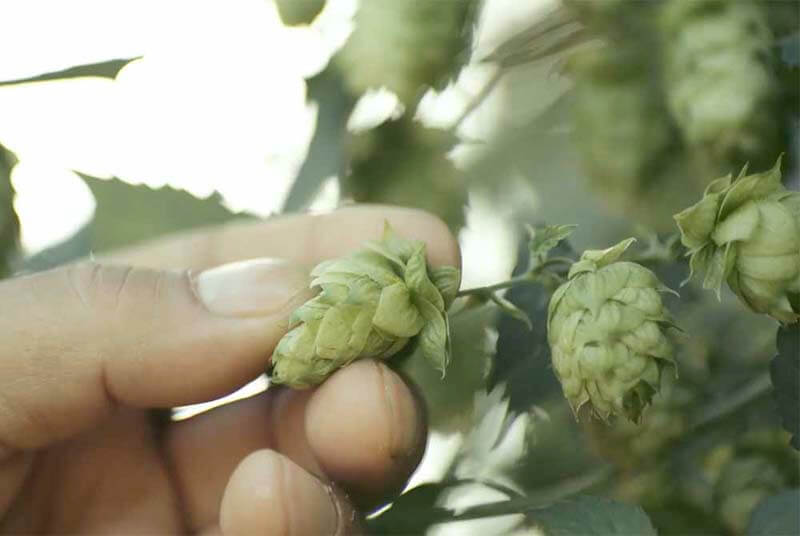The Complete Guide to All American Hop Varieties

August 22, 2022

Undeniably, hops are hot. Now more than ever consumers are clamoring for the tiny little green cones that give your beers their characteristic aroma and flavor. In the American craft beer industry, we feel very confident saying that hops are the hottest ingredient in beer at this moment.
But you don’t have to take our word for it. With American hops most popular and pronounced in IPAs of all varieties, let’s look at the facts:
According to recent NielsenIQ data analyzed by Bump Williams Consulting (BWC), hazy imperial/double/triple IPA dollar sales increased +128.7% to $33.3 million, more than doubling. And overall, IPAs still account for 46% of craft dollar share.
Last year, during its yearly roundup of statistics on the app, Untappd discovered that four of the top five styles fell into the IPA category, with American IPAs snagging the top spot with a total of over 7.2 million check-ins and New England-style / hazy IPAs not far behind with over 6.1 million check-ins. And just to give you some perspective, the American IPA category has held the top spot on this yearly list for the last eleven years.
As a brewer or brewery owner, we’re not telling you something surprising here. But armed with the knowledge that these beautiful bines are here to stay, it’s worth diving a bit deeper into the enormous breadth of hops at your disposal.
Editor's Note: This is part one of a three-part series covering hops across the world. For this piece, we’ll cover hops native to America, but check out our pieces on Southern Hemisphere hops and European/Noble hops.
What We’ll Cover in This Piece:
What’s Hot in Hops Right Now?

Without a doubt, the global pandemic changed the craft beer industry. Many brewers are still feeling the ripple effects, including with hops.
“Currently, the market is interestingly enough shifting from more expensive proprietary hops to less expensive public or less expensive proprietary hops,” says Jeff Perkins, CEO of Yakima Valley Hops, the source for the highest-quality hops from both the Yakima Valley and premium growing regions around the world, in an article for Hop Culture. “That’s due to the cost of business increasing, and COVID has caused a lot of breweries to shut down and reopen.”
According to Perkins, this COVID coaster meant many breweries renewed focus on their flagship beers. As opposed to experimenting with some of the more expensive or hard-to-find hop varieties.
Makes sense that in a time of turmoil we return to what we know best. And what we know works well.
“People are going back to the hops they know and have used again and again,” says Perkins, citing that Yakima Valley Hops’ Citra® sales have stayed consistent.
For that very reason, Perkins notes that there haven’t been a ton of new hop varieties released into the market the past couple of years.
Still, although the past couple of years have been tumultuous, brewers have persevered. Whether that’s exploring new hop technology that maximizes efficiency and flavor (Read: Cryo Hops, Cold IPAs, Phantasm, hop oil extracts, liquid hop terpenes, hop blends) or doubling down on the most popular hops.
What Are the Ten Hottest Hops of 2022?

Yes, there are certain American hop varieties that are currently top of everyone’s mind. We bet you can name them: Citra®, Mosaic®, Simcoe®, CTZ (i.e. Columbus, Tomahawk®, and Zeus), and Amarillo®. Maybe even the old-school Cascade, Chinook, and Centennial still sneak onto that list, too.
But again, let’s turn to the data to actually see what hops are covering the most ground in the U.S. According to a National Hop Report from the United States Department of Agriculture, the Yakima Valley, which alone produced seventy-three percent of all hops in the United States in 2021, shows these following hop varieties leading the way: Citra®, Columbus/Tomahawk®/Zeus (CTZ), Mosaic®, Simcoe®, and Pahto.
Jamie Bogner at Craft Beer & Brewing puts together yearly illustrations showcasing the growth of certain hops in the Pacific Northwest based on The Hop Growers of America 2021 Statistical Report. This past June, the graphic showed the following hops at the top: Citra®, Mosaic®, CTZ, Cascade, Simcoe®, Centennial, Pahto, Amarillo®, Chinook, and El Dorado®.

Similarly, that same Hop Growers of America 2021 Statistical Report reported that the following ten hops covered the most amount of the Pacific Northwest by acreage: Citra®, CTZ, Mosaic®, Simcoe®, Cascade, Centennial, Pahto, Amarillo®, Chinook, and El Dorado®.

Categorically, these are the hottest hops on the market right now just based on the statistics. (Of course, ask a brewer to name their favorite ten hops and you’ll get ten probably wildly different answers.)
But we’ve only just scratched the surface here. Quite simply: a sheer number of hops exist in America.
As a brewer or brewery owner, it’s important to not only understand what hops are hot, but also the specs behind these varieties.
For that reason, we’ve put together a handy cheat sheet.
A Complete Guide to All American Hop Varieties

After looking at the currently most-trending hops in America, we’ve put together a complete list of American hops along with some essential information to know about each including: description, type, alpha acid range, aroma notes, best beer styles, and possible substitutions.
Editor’s Note: Consider this a cheat sheet. We’re not brewers, so we can’t proclaim this is the most exhaustive guide. For that reason, we’ve sourced all of the information below from a few very reputable hop vendors, merchants, and growers.* All descriptions and alpha acid ranges come courtesy of Yakima Chief Hops (YCH), one of the most respected hop merchants in the business. The aroma notes and best beer styles come from a combination of research from YCH and Yakima Valley Hops. And the substitution suggestions are courtesy of YCH and Beer Maverick.
* To get the best and most up-to-date information on any hop variety, be sure to ask your own vendors, hop merchants, or hop growers.
Simply click on the name of the hop listed below to learn more about it.
Ahtanum®
Description: Bred by Yakima Chief Ranches, Ahtanum® Brand YCR 1 is an aroma-type cultivar used for its aromatic properties and moderate bittering. The hop is named after the location where Charles Carpenter established the first hop farm east of the Cascade Mountains in Washington State in 1869.
Type: Aroma
Alpha Acid Range: 5.7-6.3%
Aroma Notes: Citrus grapefruit, and geranium
Best Beer Styles: India Pale Ale (IPA), pale ale, hefeweizen, American ales, lagers, California common, bitters
Substitutions: Cascade, Amarillo®, Simcoe®, Centennial, Willamette
Amarillo®
Description: Discovered and introduced by Virgil Gamache Farms in Washington State, Amarillo® Brand VGXP01 is an aroma variety that has recently become one of the top 10 varieties utilized by the craft beer industry. It features relatively high alpha acids along with extremely high levels of myrcene for citrus and grapefruit flavors. Amarillo® demonstrates good resistance to downy and powdery mildew.
Type: Aroma
Alpha Acid Range: 7-11%
Aroma Notes: Grapefruit, orange, lemon, melon, apricot, and peach
Best Beer Styles: American wheat, American pale ale (APA), American IPA, amber wheat
Substitutions: Cascade, Centennial, Simcoe®
Bitter Gold
Description: Released in 1999, Bitter Gold is a high-alpha variety with excellent aroma capabilities. Its lineage includes Brewer's Gold, Bullion, Comet, and Fuggle. Bitter Gold offers limited aroma when used as a bittering hop but delivers diverse stone and tropical fruit flavors in later additions.
Type: Dual Purpose
Alpha Acid Range: 12-14.5%
Aroma Notes: Pear, watermelon, stone fruit, and fresh cut grass
Best Beer Styles: Ale, lager, pilsner, bitters, IPA
Substitutions: Galena, Nugget
Bravo™
Description: Developed by Hopsteiner Breeding Company and released in 2006, Bravo™ is a second-generation super-alpha variety. It is an excellent bittering variety but showcases pleasant fruit and sweet floral aroma characteristics too.
Type: Bittering
Alpha Acid Range: 15-18%
Aroma Notes: Orange, vanilla, and floral
Best Beer Styles: IPA, APA, extra special bitter (ESB)
Substitutions: Columbus, Zeus, Apollo, Magnum, Nugget
Brewers Gold
Description: Bred at Wye College in 1919, Brewer’s Gold is an ancestor to many major high-alpha hops, including Sterling, Galena, Horizon, Centennial and Nugget. It is an English variety; however, American-grown Brewer’s Gold contains higher levels of alpha acids than its English counterpart.
Type: Bittering
Alpha Acid Range: 8-11%
Aroma Notes:Black currant and spicy
Best Beer Styles: IPA
Substitutions: Bullion, Cascade, Galena, Northern Brewer, Northdown
Cascade
Description: Originating from the USDA-ARA breeding program, Cascade is an aroma-type cultivar bred in 1956 and released in 1972. It was developed by open pollination of a Fuggle seedling. Cascade is the most popular variety in craft brewing and is known for having a unique floral, spicy, and citrus character with balanced bittering potential.
Type: Aroma
Alpha Acid Range: 4.5-9%
Aroma Notes: Medium intense floral, citrus, and grapefruit tones
Best Beer Styles: Pale ale, IPA, porter, barleywine
Substitutions: Centennial, Amarillo®, Columbus
Cashmere
Description: Released by Washington State University in 2013, Cashmere is a daughter of Cascade, containing Northern Brewer germplasm through the male parent. It contains higher alpha acid content than Cascade and twice as much humulene, providing smooth bitterness and a mild citrus fruit aroma.
Type: Dual purpose
Alpha Acid Range: 7-10%
Aroma Notes: Berry, grapefruit, grassy, herbal, and stone fruit
Best Beer Styles: Pale ale, IPA, saison, wild ales, American blonde, and American amber
Substitutions: Cascade
Centennial
Description: Bred in 1974 and released by Washington State University in 1990, Centennial is an aroma-type cultivar that has found favor as one of the most popular varieties in craft brewing. It is often referred to as a super-Cascade (containing nearly double the alpha content) and can be used for bittering purposes. Centennial is a diploid cross between Brewer's Gold and a USDA male.
Type: Dual purpose
Alpha Acid Range: 8.5-12%
Aroma Notes: Lemon and floral
Best Beer Styles: Pale ale, amber ale, American IPA, American blonde, American stout, American wheat, DIPA, barleywine, red ale
Substitutions: Cascade, Amarillo®, Chinook, Simcoe®
Chelan
Description: Similar to Galena but with higher alpha acids, Chelan was developed by the John I. Haas, Inc. breeding company and released in 1994.
Type: Bittering
Alpha Acid Range: 13.5-15.5%
Aroma Notes: Mild floral and citrus characteristics
Best Beer Styles: American ale
Substitutions: Galena, Nugget
Chinook
Description: Developed by the USDA breeding program in Washington State and released in 1985 as a high-alpha bittering variety, Chinook is a cross between Petham Golding and a USDA male. In recent years, it has found favor as a dual-purpose hop in the craft brewing community as a result of its spice and pine aroma characteristics.
Type: Dual purpose
Alpha Acid Range: 12-14.5%
Aroma Notes: Grapefruit, spice, and pine
Best Beer Styles: APA, American IPA, American stout, American porter, American amber, American brown, American barleywine, American lager, winter ale
Substitutions: Nugget, Columbus, Tomahawk®, Zeus, CTZ, Northern Brewer, Galena
Citra®
Description: Developed by Hop Breeding Company and released in 2007, Citra® Brand HBC 394 features fairly high alpha acids and total oil contents with a low percentage of cohumulone. It is tolerant to downy mildew and powdery mildew with good pickability of dense, medium-sized cones. Comprised of Hallertau Mittelfrüh, US Tettnang, Brewer's Gold, and East Kent Golding.
Type: Aroma
Alpha Acid Range: 12-15%
Aroma Notes: Grapefruit, melon, lime, gooseberry, passion fruit, and lychee
Best Beer Styles: APA, American IPA, double IPA (DIPA), amber ale
Substitutions: Simcoe®, Mosaic®
Cluster
Description: Cluster is one of the oldest hop varieties grown in the United States and, until the late 1970s, accounted for the majority of the country’s hop acreage. Its pedigree is unknown; however, hybridization of imported varieties and indigenous male hops has been suggested. Cluster is an excellent dual-purpose hop and is often used in the reproduction of historical beer styles.
Type: Dual purpose
Alpha Acid Range: 6-9%
Aroma Notes: Floral, earthy, and sweet fruit
Best Beer Styles: Barleywine, English pale ale, amber ale, honey ale, cream ale, American lager
Substitutions: Eroica, Galena
Columbia
Description: Selected in 1967 at Oregon State University in Corvallis, Oregon, Columbia is a descendant of Fuggle and sister selection of Willamette. Commercial production was discontinued in the early 1980s in favor of Willamette; however, small quantities are again being produced.
Type: Dual purpose
Alpha Acid Range: 5-6%
Aroma Notes: Earthy, fruity
Best Beer Styles: Ales
Substitutions: Centennial, Chinook
Columbus
Description: Originally selected by Charles Zimmerman for Hopunion, Inc., Columbus is a descendant of Nugget. It is a high-alpha variety and is primarily used for bittering purposes. Columbus is often referred to as CTZ, a trio of similar hops including Tomahawk® and Zeus.
Type: Bittering
Alpha Acid Range: 14.5-17.5%
Aroma Notes: Black pepper, licorice, curry, and subtle citrus
Best Beer Styles: APA, IPA, imperial IPA, imperial red ale, imperial brown ale, barleywine, stout, lager
Substitutions: Zeus, Tomahawk®, Chinook, Galena, Millennium, Nugget
Comet
Description: Selected in 1961 and released in 1974 by the USDA, Comet was originally utilized for its high alpha acid content and adaptability to growing conditions in the Yakima Valley. Commercial production ceased in the early 1980s in favor of newer super-alpha hops; however, Comet has made a recent comeback, finding favor with some brewers in dual-purpose applications for its subtle and unique, wild American aroma.
Type: Bittering
Alpha Acid Range: 8-10.5%
Aroma Notes: Subtle wild American, grassy, and grapefruit
Best Beer Styles: Lager, American ale, IPA, ale
Substitutions: Galena, Summit™
Crystal
Description: Bred in 1983 by the USDA, Crystal is a triploid aroma-type cultivar from Hallertau Mittelfrüh, Cascade, Brewer's Gold, and Early Green. It is primarily grown in Oregon and has become increasingly popular among craft brewers due to its versatility in a variety of beer styles.
Type: Aroma
Alpha Acid Range: 3-6%
Aroma Notes: Woody, green, citrus, and herbal
Best Beer Styles: Bitters, pilsner, light lager, golden ale, nut brown ale, pale ale, IPA, stout, chocolate stout, American lager
Substitutions: Liberty, Mount Hood, German Hallertau, Ultra, Strisselspalter, Hersbrucker
El Dorado®
Description: El Dorado was released by CLS Farms in the fall of 2010. El Dorado’s high alpha acid levels combined with its unique aromas give craft brewers maximum supply chain flexibility
Type: Dual purpose
Alpha Acid Range: 13-16%
Aroma Notes: Citrus, stone fruit, tropical, woody
Best Beer Styles: Amber ales, IPAs, pale ales, wheats, German-style beers, stouts
Substitutions: Citra®, Nelson Sauvin, Rakau
Eukanot®
Description: Developed by Hop Breeding Company and released in 2014, Ekuanot® HBC 366 features pronounced aroma characteristics and extremely high oil content. This variety bursts out of the spring soil in vibrant yellow and gradually matures to a deep green color by fall harvest.
Type: Aroma
Alpha Acid Range: 14-16%
Aroma Notes: Melon, berry, orange peel, lime, papaya, pine, and fresh peppers
Best Beer Styles: Pale ales, IPA
Substitutions: Citra®, Galaxy
Falconer’s Flight 7Cs®
Description: Developed by Hopunion LLC in 2011, Falconer's Flight hop pellets are an exclusive proprietary hop blend created to honor and support the legacy of Northwest brewing legend Glen Hay Falconer. Proceeds from each Falconer's Flight purchase is contributed to the Glen Hay Falconer Foundation. The proprietary blend combines seven “C” hops and additional experimental varieties.
Type: Aroma
Alpha Acid Range: 9-10.5%
Aroma Notes: Strong fruit and citrus characteristics with layers of spicy and earthy overtones
Best Beer Styles: US-style IPAs, pale ales, lagers, black IPAs, APAs
Substitutions: Citra®, Simcoe®, Amarillo®, Falconer's Flight®, Cascade, Centennial, Chinook, Columbus, Cluster, Crystal
Falconer’s Flight®
Description: Developed by Hopunion LLC in 2010, Falconer's Flight® hop pellets are an exclusive proprietary hop blend created to honor and support the legacy of Northwest brewing legend Glen Hay Falconer. Proceeds from each Falconer's Flight purchase are contributed to the Glen Hay Falconer Foundation. These hop pellets are an excellent complement to many IPA and pale ale-oriented hop varieties.
Type: Aroma
Alpha Acid Range: 9.5-12%
Aroma Notes: Distinct tropical, floral, lemon, and grapefruit characteristics
Best Beer Styles: IPA, pale ale, lager
Substitutions: Cascade, Columbus, Centennial
Fuggle (US)
Description: Similar to English Fuggle but with slightly higher alpha.
Type: Aroma
Alpha Acid Range: 4-5.5%
Aroma Notes: Mild, wood, mint, grass, and subtle fruit
Best Beer Styles: English pale ale, Belgian IPA, ESB, brown ale, red ale
Substitutions: Fuggle (UK), Willamette, Styrian Golding, Tettnanger (GR)
Galena
Description: Developed by the USDA breeding program in Idaho in 1968 and released in 1978, Galena is an open-pollinated cross of Brewer’s Gold. It is a high-alpha variety with increasingly popular aroma characteristics.
Type: Bittering
Alpha Acid Range: 13-15%
Aroma Notes: Sweet fruits, pear, pineapple, blackcurrant, grapefruit, lime, gooseberry, and spicy wood
Best Beer Styles: Imperial stout, stout, IPA, barleywine
Substitutions: Nugget, Columbus, Zeus, Chinook, Pride of Ringwood, Eroica, Newport, Cluster, Brewers Gold
Glacier
Description: Released in 2000 by Washington State University, Glacier is an offspring of French Elsasser, Brewer's Gold, and Northern Brewer. It was selected for its good yield potential and low cohumulone, providing smoothness and balanced bitterness in beer.
Type: Dual purpose
Alpha Acid Range: 4-7.5%
Aroma Notes: Plum, blackberry, and wood
Best Beer Styles: ESB, IPA, wheat beer, APA
Substitutions: Willamette, Fuggle (US), Tettnanger (GR), Golding (US)
Golding
Description: Golding hops consist of a group of traditional English aroma varieties which have been cultivated since 1790. The cultivar originated in England and the hops were named after villages in East Kent (Petham, Rotherham, Canterbury, Eastwell). US Golding is the Canterbury strain. It is susceptible to downy mildew but has good pickability of small-sized, moderately compact cones.
Type: Aroma
Alpha Acid Range: 3-6.5%
Aroma Notes: Delicate and sweet floral
Best Beer Styles: Bitter, pale ale, Belgian ale, Belgian IPA, barleywine, imperial stout, red ale, Irish stout, APA
Substitutions: East Kent Golding, Fuggle, Willamette, Savinjski Golding, Progress, Whitbread Golding
Hallertau (US)
Description: US Hallertau originates from the classic Hallertau variety of Germany. It is a noble aroma variety. Despite low yield and low resistance to disease, Hallertau remains a historic hop and is often celebrated in the production of purist recipes and traditional beer styles
Type: Aroma
Alpha Acid Range: 3.5-5.5%
Aroma Notes: Noble, earthy, and herbal
Best Beer Styles: German pilsner, pale ale, wheat, American lager
Substitutions: Liberty, Hallertau (US), Hallertauer Tradition
HBC 431
Description: An experimental variety made by the Hop Breeding Company, a joint venture between Yakima Chief Ranches and John I. Haas, HBC 431 interestingly carries the highest xanthohumol content of any hop. Xanthohumol is a potent antioxidant, 200 times more powerful than antioxidants found in red wine. Used in Paulaner’s hop selection for their Oktoberfest bier.
Type: Dual purpose
Alpha Acid Range: 14-16%
Aroma Notes: Peach, berry, tropical fruit, citrus, and herbal
Best Beer Styles: NA
Substitutions: NA
HBC 472
Description: Bred by Hop Breeding Company through open pollination of a wild American hop subspecies neomexicanus, HBC 472 is a dual-purpose variety still in the experimental phase. The hop displays a unique aroma profile consisting of floral, wood, earth, and coconut characteristics. When hopped aggressively in IPA-style beers, citrus and grapefruit aromas emerge, along with a distinct whiskey/bourbon and coconut character in the background. These characteristics are especially evident in darker, malt-forward beers.
Type: Aroma
Alpha Acid Range: 9-12%
Aroma Notes: Floral, wood, coconut, and distinct whiskey/bourbon
Best Beer Styles: Pale ales, IPAs, porters, stouts, and barrel-aged beers
Substitutions: NA
Horizon
Description: Bred in Oregon in 1970 and released in 1997, Horizon is a descendant of Brewer's Gold and half-sister to Nugget. Its low cohumulone is similar to noble varieties and provides smoothness to beer; however, alpha acid levels can reach as high as 12%. Horizon can be utilized in every stage of the brewing process.
Type: Dual purpose
Alpha Acid Range: 8.8-12%
Aroma Notes: Floral and spicy
Best Beer Styles: Light ale, red ale, pumpkin ale
Substitutions: Hallertauer Magnum
Idaho 7®
Description: Idaho 7® Brand was bred and released by Jackson Farms in Wilder, Idaho.
Type: Dual purpose
Alpha Acid Range: 12-15%
Aroma Notes: Berry, bubblegum, citrus, stone fruit, and tropical
Best Beer Styles: IPA, pale ale, hop-forward American wheat beers
Substitutions: Azacca, El Dorado®, Cashmere, Citra®, Idaho Gem™, Amarillo, Chinook, Columbu
Idaho Gem™
Description: Named after its home state, Idaho Gem was found by Gooding Farms in Parma. Rich levels of sweet, fruit-forward aromatic oils make Idaho Gem™ optimal for late kettle additions or dry hopping in a wide variety of styles, whether alone or in a blend.
Type: Dual purpose
Alpha Acid Range: 12-14%
Aroma Notes: Berry, bubble gum, citrus, floral, and mint
Best Beer Styles: IPA and pale ale
Substitutions: Azacca, El Dorado®, Cashmere, Citra®, Idaho 7®, Cascade
Jarrylo®
Description: Jarrylo (pronounced Jar-ril-low) is named after Jarilo, the Slavic god of fertility and springtime. Bred by the Association for the Development of Hop Agronomy (ADHA), Jarrylo is a smaller hop with a shorter bine that makes it easier to harvest. High in alpha acids, Jarrylo comes from the Summit family.
Type: Dual purpose
Alpha Acid Range: 12-14%
Aroma Notes: Citrus, fruity, herbal, spicy, and woody
Best Beer Styles: American IPA, APA, saison, Belgian ale, pilsners, lager, wheat, wild ale
Substitutions: Motueka, Nelson Sauvin, Mosaic®
Liberty
Description: Bred in 1983, Liberty is an extension of the Hallertau hop family. It is a half-sister to Ultra, Mt. Hood, and Crystal. Liberty displays mild floral and spice characteristics with some subtle citrus notes.
Type: Aroma
Alpha Acid Range: 4-6%
Aroma Notes: Noble, delicate, floral bouquet, and spice
Best Beer Styles: Bock, lager, pale ale
Substitutions: Hallertau, Mount Hood, Tradition
Loral®
Description: Developed by Hop Breeding Company and released in 2016, Loral® HBC 291 has a noble heritage that straddles the fence between old- and new-world hop aromatics. It has the ability to complement all beer styles, making it a very versatile hop in the brewery. Loral® has been described as pleasant with floral, citrus, peppery, and some dark fruit characteristics.
Type: Dual Purpose
Alpha Acid Range: 11-13.5%
Aroma Notes: Very pleasant, floral, peppery, lemon-citrus and dark fruit, and herbal
Best Beer Styles: IPA, APA, American wheat ale
Substitutions: Glacier, Nugget, Strisselspalt, Tardif De Bourgogne
Magnum
Description: Bred at the Hop Research Center in Hüll in 1980 and released in 1993, Magnum is a German variety (also grown in the U.S.) and daughter of Galena. It is a high-alpha cultivar and is often used as the base bittering variety. Magnum does not display any distinct aroma characteristics; however, subtle spice and fruit characteristics have been noted by some brewers.
Type: Bittering
Alpha Acid Range: 12-15.5%
Aroma Notes: Citrus, grassy, herbal, and pineapple
Best Beer Styles: APA, American IPA, strong ale, American lager
Substitutions: Galena, German Magnum, Horizon, Northdown, Northern Brewer
Millenium
Description: Bred by the John I. Haas breeding program and released in 2000, Millennium is a super-alpha variety with mild, herbal aromas. It is a descendant of Nugget.
Type: Bittering
Alpha Acid Range: 15.5-18.5%
Aroma Notes: Floral, fruity, herbal, resin, toffee, and pear
Best Beer Styles: Stout, ale, American ale
Substitutions: Nugget, Columbus, Summit™, CTZ
Mosaic®
Description: Developed by Hop Breeding Company and released in 2012, Mosaic® HBC 369 contains high alpha content and features a unique and complex aroma profile that translates favorably into a variety of beer styles. It is a daughter of Simcoe® YCR 14 and a Nugget-derived male. Mosaic® is named in honor of the artistic assortment of aromas and flavors it is capable of presenting.
Type: Aroma
Alpha Acid Range: 11-14%
Aroma Notes: Earthy, blueberry, tangerine papaya, rose, blossoms, grass, and bubblegum
Best Beer Styles: IPA, pale ale, DIPAs
Substitutions: Citra®, Simcoe®
Mt. Hood
Description: Bred in 1983 and released in 1989 from the USDA breeding program in Oregon, Mount Hood is an American-bred triploid aroma-type cultivar stemming from German Hallertau Mittelfrüher and German Hersbrucker. Popular among American craft brewers, it is named after the famous Oregon volcano.
Type: Aroma
Alpha Acid Range: 4-6%
Aroma Notes: Herbal, pungent, hay, and spicy
Best Beer Styles: Hefeweizen, doppelbock, Russian imperial stout, brown ale, golden ale, pale ale, amber ale, weizenbock, IPA, holiday lager, bock, American wheat, Munich helles, American lager
Substitutions: Crystal, Strisselspalter, Hersbrucker
Mt. Rainier
Description: Bred by Oregon State University, Mt. Rainier is a dual-purpose variety with noble aroma characteristics. It is similar to the classic German variety Hallertau Mittelfrüh but features more bittering strength.
Type: Dual purpose
Alpha Acid Range: 5-7%
Aroma Notes: Noble, licorice, and floral
Best Beer Styles: Lager, American ale, porter
Substitutions: Hallertau, Fuggle
Newport
Description: Bred to be resistant to powdery mildew and released in 2002 by the USDA, Newport is a descendant of the classic bittering variety Magnum. It contains high alpha acid, cohumulone, and myrcene content, offering more distinct aroma characteristics than its parent.
Type: Bittering
Alpha Acid Range: 10.5-12.5%
Aroma Notes: Spicy
Best Beer Styles: Pale ale, American lager
Substitutions: Brewer's Gold, Fuggle, Galena, Magnum, Nugget
Northern Brewer
Description: Bred in England in 1934 from a Canterbury Golding plant and male seedling of Brewer's Gold, Northern Brewer is mainly grown in the United States and Germany. US Northern Brewer contains slightly higher alpha acids and high myrcene oil content resulting in herbal, wood, and peppery aroma characteristics; it is suitable for any stage of the brewing process.
Type: Dual purpose
Alpha Acid Range: 7-10%
Aroma Notes: Evergreen, wood, and mint
Best Beer Styles: Porter, ale, kölsch, Munich helles, ESB, German lager, California common
Substitutions: Galena, Perle, Magnum, Chinook, German Northern Brewer
Nugget
Description: Bred in 1970 by the USDA breeding program in Oregon and released in 1983, Nugget is a high-alpha cultivar that is beginning to gain some acceptance as a dual-purpose variety. Its lineage includes Brewer’s Gold, Canterbury Golding, and Early Green.
Type: Bittering
Alpha Acid Range: 13-16%
Aroma Notes: Citrus, stone fruit, tropical, and woody
Best Beer Styles: IPA, imperial IPA, ale, stout, barleywine, saison, biere de garde
Substitutions: Galena, Magnum, Columbus
Olympic
Description: Released for commercial production in 1983, Olympic is a descendant of Brewer’s Gold, Fuggle, and East Kent Golding. It is primarily used as a bittering hop; however, some subtle citrus and spice aroma characteristics have been noted.
Type: Dual purpose
Alpha Acid Range: 11.5-13.5%
Aroma Notes: Citrus and spicy
Best Beer Styles: Stout, dark ale, pale ale
Substitutions: Brewers Gold, Chinook, Galena
Palisade®
Description: Developed by Yakima Chief Ranches, Palisade® YCR 4 is known for its high yield and unique aroma profile. With moderate alpha acid, Palisade® borders on being a dual -purpose hop; however, more complex characteristics are seen in later additions.
Type: Aroma
Alpha Acid Range: 6.5-9.5%
Aroma Notes: Apricot, grass, and clean floral characteristics
Best Beer Styles: Golden ale, pale ale, English ales, APA
Substitutions: Styrian Golding, Willamette, Glacier, Chinook
Pahto (HBC 682)
Description: Released by the Hop Breeding Company, Pahto HBC 682 is the first high-alpha bittering hop from HBC that has been considered to provide a smooth bitterness and pleasant mild flavor with a clean finish.
Type: Bittering
Alpha Acid Range: 18-21%
Aroma Notes: Strong, earthy, spicy, and herbal
Best Beer Styles: IPA, pale ale, stout
Substitutions: NA
Pekko®
Description: Pekko is named for the Finnish god of field and crops. Pekko’s complex and clean characteristics of floral, citrus, and mint lend itself to many different styles of beer.
Type: Dual purpose
Alpha Acid Range: 13-16%
Aroma Notes: Citrus, floral, and herbal
Best Beer Styles: Ale, pale ale, pale lager
Substitutions: Saaz, Azacca
Perle (U.S.)
Description: Bred at the Hop Research Institute in Hüll and released in 1978, Perle is a cross between Northern Brewer and 63/5/27M. It is tolerant to most diseases and is grown in both Germany and the United States. Perle is known for adding a traditional, German-like quality to beer.
Type: Dual purpose
Alpha Acid Range: 7-9.5%
Aroma Notes: Floral and spicy
Best Beer Styles: Hefeweizen, Belgian strong ale, lager, pilsner, kölsch
Substitutions: Perle (GR), Northern Brewer (GR)
Sabro®
Description: Sabro® HBC 438 is the newest release from the Hop Breeding Company. Sabro® is an aroma hop that is notable for its complexity of fruity and citrus flavors. Sabro®’s pedigree is the result of a unique cross-pollination of a female neomexicanus hop. With a robust brewing performance, Sabro® proves to be a strongly expressive hop that translates its flavor incredibly well into beer.
Type: Dual purpose
Alpha Acid Range: 12-16%
Aroma Notes: Peachy stone fruit, tropical pineapple, and lime with herbal notes of cedar and coconut
Best Beer Styles: IPA, pale ale, fruit beer, porter, and stout
Substitutions: Talus
Santiam
Description: Released in 1997 by the USDA, Santiam is a triploid selection from Tettnang, Hallertau Mittelfrüh, and a cultivar derived from Cascade. It is an American aroma variety with noble hop characteristics.
Type: Aroma
Alpha Acid Range: 6-9%
Aroma Notes: Black pepper, floral, and spice
Best Beer Styles: American blonde ale, American lager, IPA, APA, wheat, bock
Substitutions: Tettnanger, Spalter, Spalter Select, Hallertau, Liberty
Simcoe®
Description: Developed by Yakima Chief Ranches and released in 2000, Simcoe® YCR 14 is known for its brewing versatility and unique aroma characteristics. It contains high alpha and continues to rise in popularity becoming one of the top ten varieties in craft and home brewing industries.
Type: Dual purpose
Alpha Acid Range: 12-15.5%
Aroma Notes: Earthy, passion fruit, pine, and berry
Best Beer Styles: APA, American IPA, American DIPA
Substitutions: Summit, Magnum, Amarillo®, Cascade, Centennial
Sorachi Ace
Description: Developed in Japan in 1984 for Sapporo Breweries, Ltd, Sorachi Ace is a cross between Brewer's Gold, Saaz, and Beikei No. 2 male. It is available in limited quantities; however, it remains a popular variety among craft brewers for its unique citrus fruit, herbal, and dill aromas.
Type: Dual purpose
Alpha Acid Range: 12-15%
Aroma Notes: Lemon, lime, and dill
Best Beer Styles: Saison
Substitutions: Southern Cross
Sterling
Description: Bred in 1990 and released in 1998, Sterling is an aroma variety with noble hop characteristics. Its lineage includes Saaz, Cascade, Brewer’s Gold, and Early Green.
Type: Dual purpose
Alpha Acid Range: 5-8.5%
Aroma Notes: Noble, grassy, and spicy
Best Beer Styles: IPA
Substitutions: Saaz
Summit™
Description: Bred by the American Dwarf Hop Association and released in 2003, Summit™ is a cross between Lexus and an unspecified male derived from numerous hops including Zeus, Nugget, and male USDA varieties. It is the first dwarf hop to be bred for production in the United States. Summit™ is mainly used as a bittering hop but does have earthy aromatic characteristics and subtle hints of citrus.
Type: Bittering
Alpha Acid Range: 15-17%
Aroma Notes: Pepper, incense, anise, orange, pink grapefruit, and tangerine
Best Beer Styles: IPA, imperial IPA, pale ale, stout, barleywine
Substitutions: Apollo, Bravo,CTZ, Zeus, Warrior, Simcoe®
Tahoma
Description: Released by Washington State University in 2013, Tahoma is one of three new public varieties to come to market. It retains the very low cohumulone characteristic of Glacier but displays slightly high alpha acid content. Tahoma is considered to be Cascade-like with a pleasant and predominantly citrus aroma profile.
Type: Aroma
Alpha Acid Range: 6-7.5%
Aroma Notes: Lemon, grapefruit, cedar, pine, spice, and pepper
Best Beer Styles: Blonde ale, wheat, lager
Substitutions: Glacier
Talus®
Description: Talus® delivers big aromas of pink grapefruit, citrus rinds, dried roses, pine resin, tropical fruits, and sage. These unique and impactful aromas remain throughout the brewing process. With Talus, what you smell in the field is what you’ll get in your glass.
Type: Aroma
Alpha Acid Range: 7-10%
Aroma Notes: Grapefruit, herbal, pine, rose, and tropical
Best Beer Styles: IPA, pale ale, wheat ale, golden ale, American lager, India Pale Lager (IPL)
Substitutions: Sabro®
Tomahawk®
Description: See CTZ. Tomahawk® is often referred to as CTZ (Columbus, Tomahawk®, and Zeus).
Type: Bittering
Alpha Acid Range: 15-17.5%
Aroma Notes: Pungent, herbal, spicy, black pepper, licorice, curry, and subtle citrus
Best Beer Styles: American IPA, APA, stout, barleywine, lager
Substitutions: Centennial, Chinook, Galena, Nugget, Millennium
Triumph
Description: Developed by John Hennings, a research geneticist at the USDA, Triumph is an aroma hop produced by crossing Nugget with USDA 21110M. With high yields and excellent brewing quality, this public variety was named for its triumph over other experimental hop varieties both in the field and in the glass—as well as Henning’s love of Triumph brand motorcycles.
Type: Dual purpose
Alpha Acid Range: 12-14%
Aroma Notes: Bubblegum, citrus, herbal, and tropical
Best Beer Styles: Lager, pale ale
Substitutions: Nugget, Hallertau
Ultra
Description: Bred by the hops research program in Corvallis, Oregon, in 1983 and released in 1995 by the USDA, Ultra is a triploid seedling of Hallertau Mittelfrüh and half-sister to Mt. Hood, Liberty, and Crystal. Ultra is related to traditional German varieties and can be utilized in similar applications.
Type: Aroma
Alpha Acid Range: 9.2-9.7%
Aroma Notes: Mild, spicy, and floral bouquet
Best Beer Styles: Oktoberfest, blonde ale, harvest ale, lager, pilsner, pale ale, American lager, bock
Substitutions: Tettnanger (GR), Saaz, Hallertauer Tradition, Liberty
Vanguard
Description: Bred in 1982 by the USDA and released in 1997, Vanguard is an aroma variety with similar characteristics to Hallertau Mittelfrüh. Vanguard is typically utilized in traditional German-style beers as a noble-type variety.
Type: Aroma
Alpha Acid Range: 4.5-6.5%
Aroma Notes: Woody, cedary, earthy, herbal, spicy
Best Beer Styles: Lager, pilsner, bock, kölsch, wheat, Munich helles, Belgian-style ales
Substitutions: Hallertau, German Hersbrucker, Mt. Hood, Liberty
Warrior®
Description: Developed by Yakima Chief Ranches, Warrior® YCR 5 was selected for its high alpha content, low cohumulone, good storage stability, and tolerance to powdery mildew. It is primarily used in brewing for its mild, clean bittering properties.
Type: Bittering
Alpha Acid Range: 15.5-18%
Aroma Notes: Mild, resinous, and subtle pine
Best Beer Styles: IPA, American ale
Substitutions: Nugget, Columbus
Willamette
Description: Released in 1976 from the USDA breeding program, Willamette is a triploid seedling of English Fuggle. For years, it was the most widely grown aroma variety in the U.S. It is named after Oregon’s Willamette River which runs through the heart of the state’s hop-growing region.
Type: Dual purpose
Alpha Acid Range: 4.5-6.5%
Aroma Notes: Floral, incense, and elderberry aromas
Best Beer Styles: Ale, American ale, pale ale, brown ale, English ale, porter
Substitutions: Fuggle, Styrian Golding, Tettnanger (US), Glacier, Styrian Golding
Yakima Gold
Description: Released by Washington State University in 2013, Yakima Gold is a cross between Early Cluster and a native Slovenian male. It is an excellent general-purpose variety with smooth bitterness and pleasant aroma characteristics.
Type:Dual purpose
Alpha Acid Range: 7-8%
Aroma Notes: Citrus, herbal, woody
Best Beer Styles: English ale, German ale, pale ale, IPA, mild ale
Substitutions: Cluster
Zeus
Description: Although genetically different, Zeus is often referred to as part of CTZ along with Columbus and Tomahawk®, a trio of similar hops.
Type: Bittering
Alpha Acid Range: 12-18%
Aroma Notes: Spicy, herbal, pungent, black pepper, licorice, and curry
Best Beer Styles: American IPA, APA, stout, barleywine, lager
Substitutions: Columbus, Centennial, Chinook, Galena, Nugget, Millennium
Zythos®
Description: Named in honor of the Greek word for beer, Zythos® was designed to complement existing IPA and pale ale hop varieties. It is an excellent blend for any hop-forward beer. Specific aroma descriptors include distinct tropical (pineapple) and citrus tones with slight pine characteristics.
Type: Aroma
Alpha Acid Range: 8-12%
Aroma Notes: Pineapple, citrus, and mild pine character
Best Beer Styles: American ale, IPA, pale ale
Substitutions: Simcoe, Amarillo®, Cascade
Looking for More Guides on Hops Around the World?

What About Southern Hemisphere Hops?
Check out: The Complete Guide to Southern Hemisphere Hops
What About European/Noble Hops?
Check out: The Complete Guide to European Noble Hops
Tap Into Over 9 Million Users in the Untappd Community
Untappd for Business can help increase your revenue while providing powerful insight and analytics about what your guests are drinking locally.
Get started by scheduling a demo with one of our experts or start a free 7 day trial - no credit card required!
